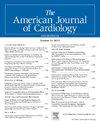Clinical Characteristics and Prognosis of Acute Heart Failure in Patients with Chronic Obstructive Pulmonary Disease
IF 2.1
3区 医学
Q2 CARDIAC & CARDIOVASCULAR SYSTEMS
引用次数: 0
Abstract
This study describes clinical profiles of acute heart failure (AHF) patients from the Heart Failure Registry of Patient Outcomes (HERO) study and evaluates the prognostic impact of chronic obstructive pulmonary disease (COPD). HERO enrolled 5,620 hospitalized AHF patients (November 2017 to 2018); 4,428 were followed. Primary endpoint: composite all-cause death or heart failure (HF) readmission. Secondary endpoints included all-cause death, HF readmission, and cardiovascular death. Patients were stratified by COPD status. Clinical characteristics were compared. Adjusted multivariate Cox regression estimated hazard ratios (HRs) with 95% confidence intervals (CIs) for COPD's impact on outcomes. Kaplan-Meier analysis (log-rank test) compared time-to-event data; sensitivity analyses were performed. Of 4,428 patients, 405 (9.2%) had COPD. COPD patients were older, more often male, had lower education, higher smoking rates, and received care predominantly in secondary hospitals. They had lower body mass index (BMI), higher heart rate, elevated hemoglobin (Hb), higher New York Heart Association (NYHA) class IV prevalence, but lower N-terminal pro–B-type natriuretic peptide (NT-proBNP). Hypertension, diabetes, and coronary artery disease were less frequent; hyponatremia was more common. Use of renin-angiotensin-aldosterone system (RAAS) inhibitors, β-blockers, statins, and diuretics was significantly lower in the COPD group. After adjustment, COPD independently predicted higher risks for the composite endpoint (HR = 1.38, 95% CI: 1.17 to 1.62, p <0.001), HF readmission (HR = 1.26, 95% CI: 1.02 to 1.55, p = 0.047), cardiovascular death (HR = 1.38, 95% CI: 1.09 to 1.74, p = 0.008), and all-cause death (HR = 1.40, 95% CI: 1.15 to 1.72, p = 0.001). Survival curves showed early and widening separation, indicating worse COPD outcomes. COPD independently increases adverse outcome risk in AHF patients. These individuals often present with poorer baseline health, leading to unfavorable prognosis. Integrated multidisciplinary care and individualized treatment are crucial to improve survival.
慢性阻塞性肺疾病患者急性心力衰竭的临床特点及预后
目的:本研究描述了心力衰竭患者结局登记(HERO)研究中急性心力衰竭(AHF)患者的临床资料,并评估慢性阻塞性肺疾病(COPD)对预后的影响。患者和方法:HERO纳入5620例AHF住院患者(2017年11月- 2018年11月);对4428人进行了跟踪调查。主要终点:复合全因死亡或心力衰竭(HF)再入院。次要终点包括全因死亡、心衰再入院和心血管死亡。患者按COPD状态分层。比较临床特征。校正多变量Cox回归估计COPD对预后影响的风险比(hr)和95%置信区间(CIs)。Kaplan-Meier分析(log-rank检验)比较时间-事件数据;进行敏感性分析。结果:4428例患者中,405例(9.2%)患有COPD。COPD患者年龄较大,多为男性,受教育程度较低,吸烟率较高,主要在二级医院接受治疗。他们的身体质量指数(BMI)较低,心率较高,血红蛋白(Hb)升高,纽约心脏协会(NYHA) IV级患病率较高,但n端前b型利钠肽(NT-proBNP)较低。高血压、糖尿病和冠状动脉疾病的发生率较低;低钠血症更为常见。肾素-血管紧张素-醛固酮系统(RAAS)抑制剂、β受体阻滞剂、他汀类药物和利尿剂的使用在COPD组中显著降低。调整后,慢性阻塞性肺病独立预测更高的风险复合端点(HR = 1.38,95%置信区间CI: 1.17 - -1.62, P < 0.001),高频重新接纳(HR = 1.26,95%置信区间CI: 1.02 - -1.55, P = 0.047),心血管死亡(HR = 1.38,95%置信区间CI: 1.09 - -1.74, P = 0.008),和全因死亡(HR = 1.40,95%置信区间CI: 1.15 - -1.72, P = 0.001)。生存曲线显示分离早期和扩大,表明COPD预后更差。结论:慢性阻塞性肺病单独增加AHF患者的不良结局风险。这些个体通常表现为较差的基线健康状况,导致不良预后。综合多学科护理和个体化治疗是提高生存率的关键。
本文章由计算机程序翻译,如有差异,请以英文原文为准。
求助全文
约1分钟内获得全文
求助全文
来源期刊

American Journal of Cardiology
医学-心血管系统
CiteScore
4.00
自引率
3.60%
发文量
698
审稿时长
33 days
期刊介绍:
Published 24 times a year, The American Journal of Cardiology® is an independent journal designed for cardiovascular disease specialists and internists with a subspecialty in cardiology throughout the world. AJC is an independent, scientific, peer-reviewed journal of original articles that focus on the practical, clinical approach to the diagnosis and treatment of cardiovascular disease. AJC has one of the fastest acceptance to publication times in Cardiology. Features report on systemic hypertension, methodology, drugs, pacing, arrhythmia, preventive cardiology, congestive heart failure, valvular heart disease, congenital heart disease, and cardiomyopathy. Also included are editorials, readers'' comments, and symposia.
 求助内容:
求助内容: 应助结果提醒方式:
应助结果提醒方式:


